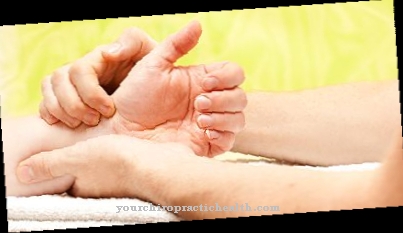The Agnosia is a neuropsychological symptom that is based on a disruption of information processing in the brain. Functional failures in certain areas of the brain may be the cause.Therapies for this disease are often based on compensation strategies.
What is agnosia?

The term agnosia comes from the Greek, means "not knowing" and is also used that way in philosophy. In medicine, however, agnosia is a rare neuropsychological symptom according to which information processing in the brain no longer functions properly. The phenomenon occurs after bilateral or unilateral lesions of certain brain regions.
The person affected can perceive all objects around him through his sensory organs. However, he is unable to correctly assign or name them. The objects are no longer recognized by him, although there are no sensory defects, cognitive disorders or attention disorders. Sigmund Freud introduced the term agnosia in medicine and exclusively meant the inability to assign the objects seen, although the ability to see is present.
According to Freud, however, this also includes cortical blindness and soul blindness. Cortical blindness is blindness due to a functional failure of the visual cortex in the brain despite healthy eyes. Soul blindness is characterized by the fact that the objects can be seen but no longer assigned. Today the term agnosia has been expanded to include failures of all sensory modalities.
causes
The causes of agnosia lie in the destruction of certain brain areas that are responsible for the corresponding information processes. These lesions can be caused by strokes, brain injuries, brain tumors, infections in the area of the meninges and the brain or also by severe mental illness.
When the rearmost part of the cerebrum in the area of the occipital lobe is damaged, visual agnosia can result. This is where the visual information processing takes place. Acoustic agnosia often occurs if the posterior temporal lobe is damaged. When the parietal lobe is damaged, one often occurs Autotopagnosia on. The affected patient can no longer localize skin stimuli on their own body.
You can find your medication here
➔ Medicines against memory disorders and forgetfulnessDiseases with this symptom
- stroke
- Brain tumor
- Meningitis
- Early summer meningoencephalitis
- Brain abscess
- Multiple organ failure
- Blood poisoning
- Anxiety disorder
- Multiple trauma
- Lymphoma in the brain
- depressions
- Post-traumatic stress disorder
- trauma
- Septic shock
- Pituitary adenoma
Diagnosis & course
There are different forms of agnosia that the doctor can easily identify. The type of agnosia already gives the doctor clues as to which brain regions are affected. To do this, he carries out various tests that relate to certain sensory areas. Generally there is a division into visual, acoustic, tactile or spatial agnosias. Then there are the auto-diagnosis and the Anosognosia.
The visual agnosia can in turn be divided into different sub-forms. This is what the so-called Prosopagnosia a disorder of facial perception. The patient does not recognize known people by their face. The recognition takes place for example via the voice or the walk. This group also includes apperceptive agnosia. Here the person affected can perceive individual elements, but they cannot put them together to form an overall object.
In the context of associative agnosia, the patient recognizes the entire object in form and shape, but cannot do anything with its function. With color diagnosis, the colors can no longer be recognized. Acoustic agnosia is characterized by the fact that the person concerned hears noises but cannot put them together into words or sentences. The inability to orientate oneself in space is called spatial agnosia. In tactile agnosia, objects that can be felt cannot be assigned.
Failure to recognize functional failures in one's own body parts or organs is known as anosognosia. Here the patient perceives the failed body parts as functional and wants to use them accordingly. This can lead to falls.
Complications
Agnosia can trigger various complications. Depending on the severity and cause of the agnosia, severe motor impairments and functional disorders of the sensory organs occur. The sense of balance, for example, is sometimes severely disturbed by the neuropsychological symptom, which can lead to falls and similar injuries. The eyes and ears are also affected and function only to a limited extent or no longer at all. The complications that follow can exacerbate the main symptoms of agnosia.
In addition, intellectual performance is usually severely restricted and can only be partially restored through occupational therapy. Further complications arise in agnosia, primarily from secondary damage such as autotopagnosia. This makes it impossible for those affected to localize skin irritations or injuries on their own body, which often leads to an intensification of existing diseases. Last but not least, the emotional state of those affected is also a risk factor.
Agnosia can lead to severe mental and physical disabilities and thus also put an enormous psychological strain on the patient. With the actual therapy, complications are rare. Often permanent damage occurs, but the occupational therapy used does not pose any great risks for those affected. In some cases, further complications can only arise in the course of drug treatment, for example necessary in the treatment of secondary psychological symptoms.
When should you go to the doctor?
As soon as relatives or the person concerned notices that he or she is suffering from a failure to recognize objects or people, a doctor should be consulted immediately and as quickly as possible. Since the sensory organs are usually not damaged, there is a risk that the initial symptoms may not be recognized immediately or the hope that the disorder will soon disappear.
With agnosia, the eyes and ears continue to function. Nonetheless, the failure to recognize objects is an elementary disturbance of perception and this must be taken very seriously. The insignificance of visual impressions in a sick person indicates brain damage, which should be examined more closely as soon as possible. In addition, when coping with everyday life there is an increased risk for those affected to suffer further damage.
If the malfunction means that a car can no longer be recognized, walking across the street must be classified as life-threatening. Agnosia can only be diagnosed and appropriate medical measures initiated through an intensive medical examination. So-called soul blindness is a lesion in the brain. Therefore, the failure to recognize objects should be understood as an immediate warning signal. A spontaneous healing or the presence of temporary effects of the restriction is unfortunately not to be expected.
Doctors & therapists in your area
Treatment & Therapy
There is no specific treatment for agnosia. If a lesion has appeared in a certain area of the brain, for example as a result of a stroke, it can improve on its own after a while. However, this depends on the size and location of the damage and the age of the patient. Most of the improvement occurs after the first three months. Even after that, processes often take place that weaken the failure.
In most cases, however, permanent disabilities must be assumed. The doctor can only initiate compensatory measures to overcome the failures. In occupational therapy, for example, an attempt is made to compensate the corresponding agnosia as well as possible with other functions that are still present. During occupational therapy treatment, the patient can learn to make greater use of other features for recognizing people and objects.
For example, in the case of agnosia, the patient does not recognize the face of someone he knows. To identify this person, however, the person affected can fall back on other characteristic features such as voice, posture or gait. Under certain circumstances, the learning process is so successful that the missing face recognition no longer plays a role and may even go unnoticed.
Ergotherapy can of course be used for all forms of agnosia. This takes advantage of the fact that, as a rule, only selective failures occur in the information processing system of the brain.
Outlook & forecast
As a rule, the patient's perception is severely disturbed by the agosnia. This mainly affects the recognition of different people's faces. Patients then try to match people based on their voice or gait. Agosnia can, however, also affect other areas of life. These include, for example, colors or shapes that cannot be recognized either. This leads to a severe restriction in everyday life for the patient. Some professions cannot be exercised through agosnia.
Unfortunately, there is no treatment for agosnia. However, exercises can be carried out that compensate for the weaknesses affected and replace them with other ways of perception. Agosnia therefore does not result in a reduced life expectancy for most people. Methods from occupational therapy or speech therapy are mainly used for treatment.
In complicated cases, certain organs can also fail completely. These include, for example, the ears or the eyes. This can severely restrict everyday life for the patient. These patients are then dependent on the help of other people.
You can find your medication here
➔ Medicines against memory disorders and forgetfulnessprevention
Agnosia cannot be prevented. There are innate and acquired forms. The congenital forms are often genetic diseases or prenatal developmental disorders. The acquired forms are caused by diseases such as strokes or other organic brain disorders. There are no prophylactic measures for all forms of agnosia.
You can do that yourself
Agnosia is not a common disease symptom, but it is a very big problem for those who suffer from it. The terms deafness and blindness of the soul used in German indicate how complex and serious the disturbance of hearing, sight or touch can be.
Because the symptom appears so individually, it is absolutely necessary to proceed patient-specifically during treatment - especially when it comes to self-help. Agnosia is usually incurable, but special forms of training can more or less compensate for the impairments. In prosopagnosia, for example, the goal is to enable patients to identify people using other identifying features than the face (posture, gait, voice, clothing, hairstyle, etc.). Sometimes it is seemingly simple measures that help - such as writing and arithmetic exercises. Which exercises should be performed must be discussed with the therapist or doctor. In general, conversation or occupational therapy is essential for treatment.
Through learning processes and memory formation, specific exercises create new neurons and synapses in the brain, which can bring about an improvement in performance. Much depends on the group of friends and family when it comes to treatment. It is advisable to ensure the social integration of the person concerned, to reduce the risk of injury in everyday life and to convey calm to him through a confident manner.
























.jpg)



